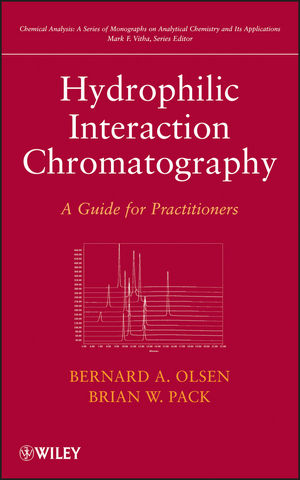
Hydrophilic Interaction Chromatography
John Wiley & Sons Inc (Verlag)
978-1-118-05417-8 (ISBN)
An increasingly popular analytical method, hydrophilic interaction chromatography (HILIC) has the ability to retain and separate polar compounds that are often difficult to analyze by reversed-phase high-performance liquid chromatography (HPLC) or other analytical methods. Offering a comprehensive review, this book enables readers to develop a fundamental understanding of how HILIC works and then apply that knowledge to develop and implement a variety of practical applications.
Hydrophilic Interaction Chromatography begins with discussions of HILIC retention mechanisms, stationary phases, and general method development. This sets the foundation for the book's extensive coverage of applications. The authors address unique separation challenges for bioanalytical, environmental, pharmaceutical, and biochemical applications. Moreover, there is a thorough discussion of HILIC in two-dimensional chromatography.
With contributions from leading analytical scientists who have extensive experience in HILIC as well as HPLC, Hydrophilic Interaction Chromatography serves as a practical guide for researchers, featuring:
Detailed examples of HILIC methods and development approaches
Thorough explanations of retention mechanisms and the impact of stationary phase and mobile phase properties on separations
Step-by-step guidance for developing efficient, sensitive, and robust HILIC methods
References to the primary literature at the end of each chapter
Hydrophilic Interaction Chromatography is written for scientists who use or develop analytical methods for the separation of polar compounds. In particular, these researchers will discover how HILIC can be used to analyze and better understand the composition of pharmaceutical, bioanalytical, biochemical, chemical, food, and environmental samples.
BERNARD A. OLSEN, PhD, has close to three decades of experience at Eli Lilly and Company in chemistry, manufacturing, and control of drug substances and drug products. He contributed to the development and support of more than twenty-five commercialized drugs as well as numerous developmental drugs. A Fellow of the American Association of Pharmaceutical Scientists, Dr. Olsen currently provides consulting and training services to the pharmaceutical industry and serves as Chair of the USP Expert Committee on Monograph Development: Small Molecules 3. BRIAN W. PACK, PhD, is a Research Advisor in Analytical Sciences R&D at Eli Lilly and Company, where he has contributed to the development of many solid oral and parenteral dosage forms. He is recognized for his contributions to HPLC method development, raw material control strategies, genotoxic impurities, cleaning validation, and colorimetry. Dr. Pack has published on the topics of HILIC applications, Raman spectroscopy, mass spectrometry, dissolution, and cleaning verification.
PREFACE xiii
CONTRIBUTORS xv
CHAPTER 1 SEPARATION MECHANISMS IN HYDROPHILIC INTERACTION CHROMATOGRAPHY 1
David V. McCalley
1.1 Introduction 1
1.2 Historical Background: Recognition of the Contribution of Partition, Ion Exchange, and RP Interactions to the Retention Process 3
1.3 Recent Studies on the Contributory Mechanisms to HILIC Retention 7
1.4 Conclusions 38
References 38
CHAPTER 2 STATIONARY PHASES FOR HILIC 43
Mohammed E.A. Ibrahim and Charles A. Lucy
2.1 Introduction 43
2.2 HILIC Stationary Phases 44
2.3 Commercial HILIC Phases 61
2.4 Conclusions 77
Acknowledgments 77
References 77
CHAPTER 3 HILIC METHOD DEVELOPMENT 87
Yong Guo and Xiande Wang
3.1 Introduction 87
3.2 General Method Development Considerations 88
3.3 HILIC Method Development 93
3.4 Detection for HILIC Methods 104
3.5 Conclusions 107
References 108
CHAPTER 4 PHARMACEUTICAL APPLICATIONS OF HYDROPHILIC INTERACTION CHROMATOGRAPHY 111
Bernard A. Olsen, Donald S. Risley, V. Scott Sharp, Brian W. Pack, and Michelle L. Lytle
4.1 Introduction 112
4.2 Determination of Counterions 117
4.3 Main Component Methods 129
4.4 Determination of Impurities 135
4.5 Excipients 146
4.6 Chiral Applications 152
4.7 Conclusions 161
References 161
CHAPTER 5 HYDROPHILIC INTERACTION CHROMATOGRAPHY (HILIC) FOR DRUG DISCOVERY 169
Alfonso Espada and Mark Strege
5.1 Drug Discovery Model 169
5.2 HILIC Applications for In Vitro Biology 170
5.4 Practical Considerations 186
5.5 Conclusions 187
References 188
CHAPTER 6 ADVANCES IN HYDROPHILIC INTERACTION CHROMATOGRAPHY (HILIC) FOR BIOCHEMICAL APPLICATIONS 195
Fred Rabel and Bernard A. Olsen
6.1 Introduction 195
6.2 Carbohydrates 196
6.2.1 Mono- and Disaccharides 196
6.3 Nucleobases and Nucleosides 203
6.4 Oligonucleotides 205
6.5 Amino Acids and Peptides 206
6.6 Proteins 209
6.7 Phospholipids 209
6.8 Conclusions 211
References 212
CHAPTER 7 HILIC-MS FOR TARGETED METABOLOMICS AND SMALL MOLECULE BIOANALYSIS 219
Hien P. Nguyen, Heather D. Tippens, and Kevin A. Schug
7.1 Introduction 219
7.2 The Role of HILIC-MS in Targeted Metabolomics versus Other LC Modes 221
7.3 Strategies for Method Development Based on Retention Behavior of Targeted Metabolites on HILIC Stationary Phases 223
7.4 Summary 231
Acknowledgments 232
References 232
CHAPTER 8 HILIC FOR FOOD, ENVIRONMENTAL, AND OTHER APPLICATIONS 239
Michael A. Koupparis, Nikolaos C. Megoulas, and Aikaterini M. Gremilogianni
8.1 Introduction 239
8.2 Food Applications for HILIC 240
8.3 Environmental and Other Applications of HILIC 254
8.4 Conclusions 257
References 259
CHAPTER 9 THEORY AND PRACTICE OF TWO-DIMENSIONAL LIQUID CHROMATOGRAPHY SEPARATIONS INVOLVING THE HILIC MODE OF SEPARATION 265
Stephen R. Groskreutz and Dwight R. Stoll
9.1 Fundamentals of Multidimensional Liquid Chromatography 265
9.2 Complementarity of HILIC Selectivity to Other Separation Modes 278
9.3 Instrumentation and Experimental Considerations 278
9.4 Applications 291
9.5 The Future of HILIC Separations in 2DLC 298
References 298
INDEX 307
| Erscheint lt. Verlag | 12.3.2013 |
|---|---|
| Reihe/Serie | Chemical Analysis: A Series of Monographs on Analytical Chemistry and Its Applications |
| Mitarbeit |
Herausgeber (Serie): Mark F. Vitha |
| Verlagsort | New York |
| Sprache | englisch |
| Maße | 163 x 241 mm |
| Gewicht | 594 g |
| Themenwelt | Naturwissenschaften ► Biologie |
| Naturwissenschaften ► Chemie ► Analytische Chemie | |
| ISBN-10 | 1-118-05417-2 / 1118054172 |
| ISBN-13 | 978-1-118-05417-8 / 9781118054178 |
| Zustand | Neuware |
| Haben Sie eine Frage zum Produkt? |
aus dem Bereich


